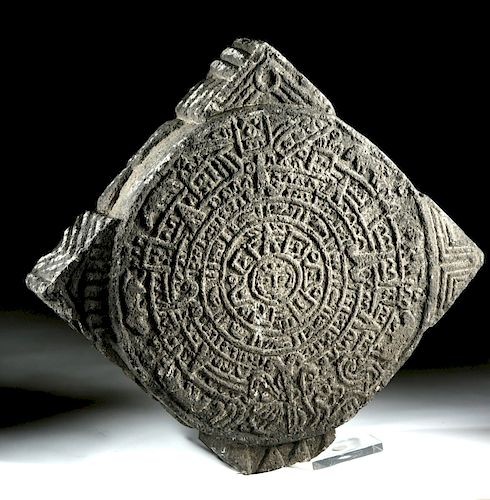Important Aztec Volcanic Stone Solar Disc, ex-Arte
Lot 144d
About Seller
Artemis Fine Arts
686 S Taylor Ave, Ste 106
Louisville, CO 80027
United States
Selling antiquities, ancient and ethnographic art online since 1993, Artemis Gallery specializes in Classical Antiquities (Egyptian, Greek, Roman, Near Eastern), Asian, Pre-Columbian, African / Tribal / Oceanographic art. Our extensive inventory includes pottery, stone, metal, wood, glass and textil...Read more
Estimate:
$50,000 - $70,000
Absentee vs Live bid
Two ways to bid:
- Leave a max absentee bid and the platform will bid on your behalf up to your maximum bid during the live auction.
- Bid live during the auction and your bids will be submitted real-time to the auctioneer.
Bid Increments
| Price | Bid Increment |
|---|---|
| $0 | $25 |
| $300 | $50 |
| $1,000 | $100 |
| $2,000 | $250 |
| $5,000 | $500 |
| $10,000 | $1,000 |
| $20,000 | $2,500 |
| $50,000 | $5,000 |
| $100,000 | $10,000 |
| $200,000 | $20,000 |
About Auction
By Artemis Fine Arts
Feb 21, 2019
Set Reminder
2019-02-21 10:00:00
2019-02-21 10:00:00
America/New_York
Bidsquare
Bidsquare : Exceptional Antiquities, Asian, Ethnographic
https://www.bidsquare.com/auctions/artemis-gallery/exceptional-antiquities-asian-ethnographic-3858
An important one-day auction featuring museum-worthy examples of Egyptian, Greek, Roman, Etruscan, Near Eastern, Far East / Asian, Pre-Columbian, African / Tribal, Oceanic, Native American, Spanish Colonial, Russian, Fossils, Ancient Jewelry, Fine Art, so much more! Artemis Fine Arts info@artemisfinearts.com
An important one-day auction featuring museum-worthy examples of Egyptian, Greek, Roman, Etruscan, Near Eastern, Far East / Asian, Pre-Columbian, African / Tribal, Oceanic, Native American, Spanish Colonial, Russian, Fossils, Ancient Jewelry, Fine Art, so much more! Artemis Fine Arts info@artemisfinearts.com
- Lot Description
Pre-Columbian, Mexico City region, Aztec, Post-classic Mexico, ca. 1400 to 1500 CE. A diamond-shaped volcanic stone, weathered to a dramatic black, with a large, round solar disc motif at its center and additional carving on the projecting sides. Additional decoration is on each corner and down the sides, with the back (as shown in the photographs) undecorated. These corner and side decorations are geometric - concentric triangles, overlaid rectangles, small tab-like shapes - and in relief. They may represent flint knives for sacrifices. They form boundaries to the large circle at the center of the piece. At the center of that circle is a sun image with an anthropomorphic face - the deity Tonatiuh, inside the glyph for "movement" ("ollin" in Nahuatl). Size: 5.5" L x 16.25" W x 16.5" H (14 cm x 41.3 cm x 41.9 cm)
This central image is comparable to the interior two rings of the famous Piedra del Sol, a nearly 12 foot wide and over 20 ton monolithic circle made in the early 1500s and discovered in 1790 underneath the Mexico City Cathedral. If you look closely at the ring around the deity's face, you can see four squares offset around the face. "Ollin" is the name of the current era when the stone was made, while the four squares represent the four previous eras, each of which ended with the destruction of the world and humanity.
On this stone, five further concentric circles ring the face of Tonatiuh. The iconography is more difficult to decipher here due to the weathered nature of the stone, but the iconography of similar stones - like the Piedra del Sol, the Tizoc Stone, the stone of Motecuhzoma I, and unnamed examples at the Philadelphia Museum of Art, Yale University Art Gallery, and Peabody Museum of Natural History - suggests that these are calendrical marks and may also indicate the location of historical events.
What was the purpose of this massive stone and ones like it? It is likely a temalacatl, a "round stone" in Nahuatl, a sculptured item used in various ways in Aztec/Mexica society. Friar Diego Duran in his "Book of the Gods and Rites" (1574 to 1576) recorded that sacrificial victims - captured warriors - were laid atop stones like this, with their blood draining into a nearby vessel. Others grace temple architecture and furniture.
Provenance: private New York, New York, USA collection; ex-Arte Primitivo Gallery, New York, New York, USA in 2015; ex-Arthur M. Bullowa collection, acquired 1950s-1970s
All items legal to buy/sell under U.S. Statute covering cultural patrimony Code 2600, CHAPTER 14, and are guaranteed to be as described or your money back.
A Certificate of Authenticity will accompany all winning bids.
We ship worldwide and handle all shipping in-house for your convenience.
#143379One corner was partially lost at some point in the past - the piece was originally square. Many of the motifs are nicely preserved, despite the weathered surface, which has gained a black patina and encrustations in the lower profile areas of the piece.Condition
- Shipping Info
-
All shipping is handled in-house for your convenience. Your invoice from Artemis Gallery will include shipping calculation instructions. If in doubt, please inquire BEFORE bidding for estimated shipping costs for individual items.
-
- Buyer's Premium



 EUR
EUR CAD
CAD AUD
AUD GBP
GBP MXN
MXN HKD
HKD CNY
CNY MYR
MYR SEK
SEK SGD
SGD CHF
CHF THB
THB















